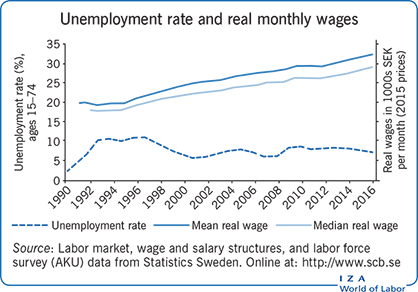Elevator pitch
The economic crisis in the early 1990s brought about a dramatic increase in unemployment and a similar decrease in labor force participation. Unemployment declined afterwards, but stabilized at around 6–7%—more than twice as high as before the crisis. Today, the unemployment rate is lower than the EU average, though Sweden no longer stands out in this respect. The 2008 financial crisis had small effects on the Swedish labor market. Employment in industry declined sharply and then remained stagnant, but employment in the service sectors has continued to grow steadily.

Key findings
Pros
Labor force participation and employment rates in Sweden have increased and are now among the highest in the EU.
The unemployment rate has been fairly stable and is below the EU average.
Labor force participation among women is close to that of men, and labor force participation among older workers is high and trending up.
Wage inequality is low and stable and women’s wages are catching up.
Real wages have increased steadily for all major groups of workers.
Cons
Labor force participation among young workers has declined.
The unemployment rate is more than twice as high as it was in the 1970s and 1980s.
Workers without upper secondary school education do poorly in the labor market, and their problems appear to be growing.
Immigrants have high unemployment rates, but there is a positive trend in participation and employment rates.
Income differentials have increased between those who have a job and those who do not.